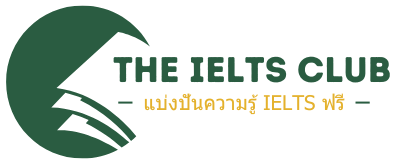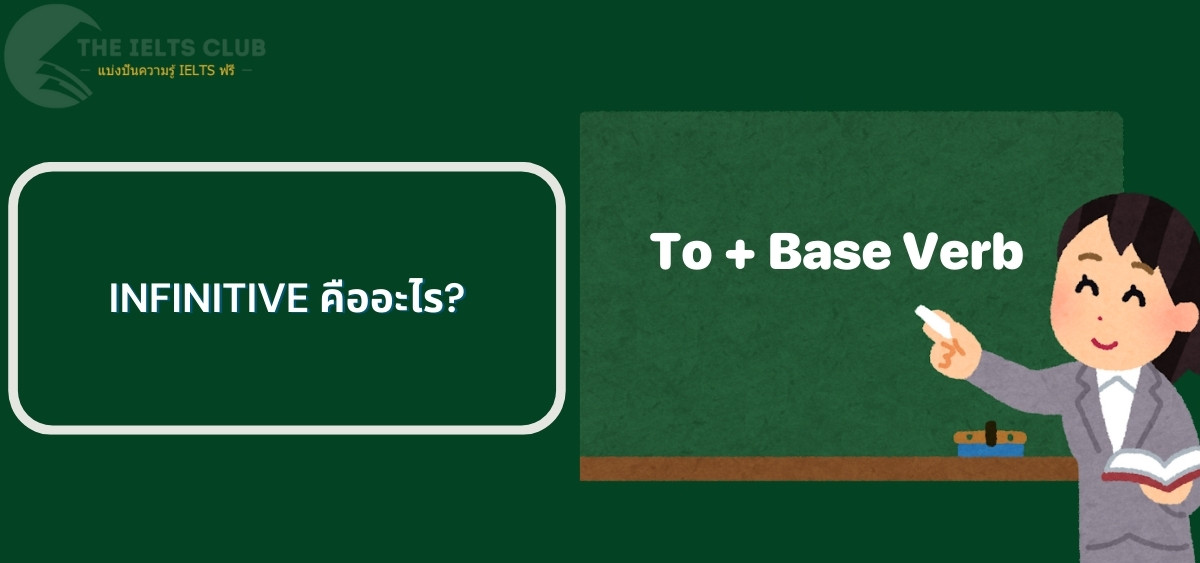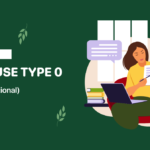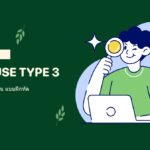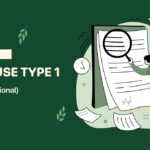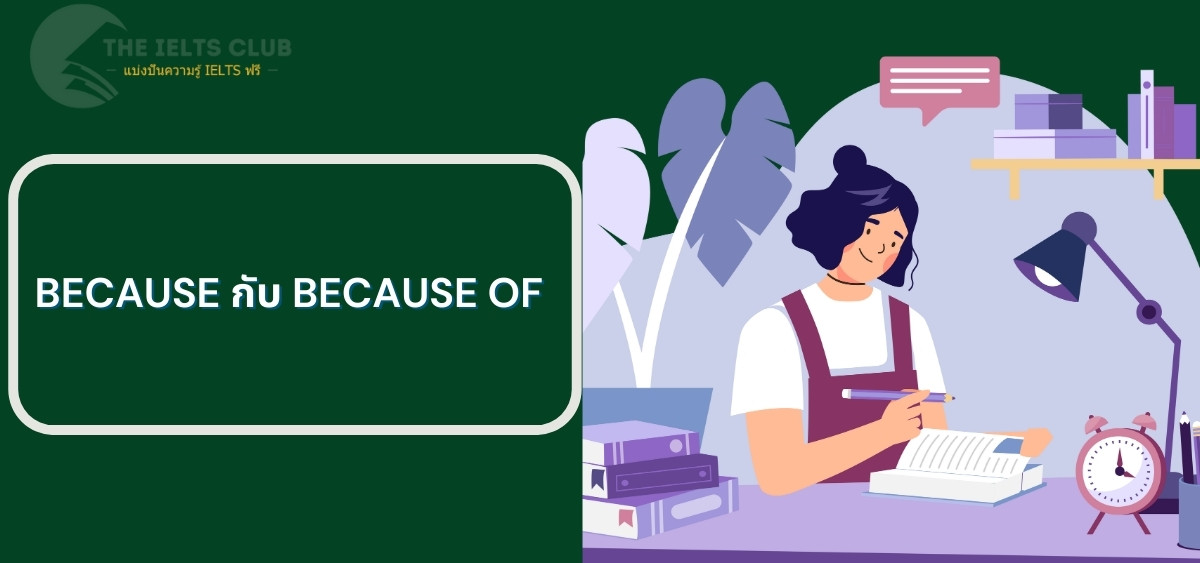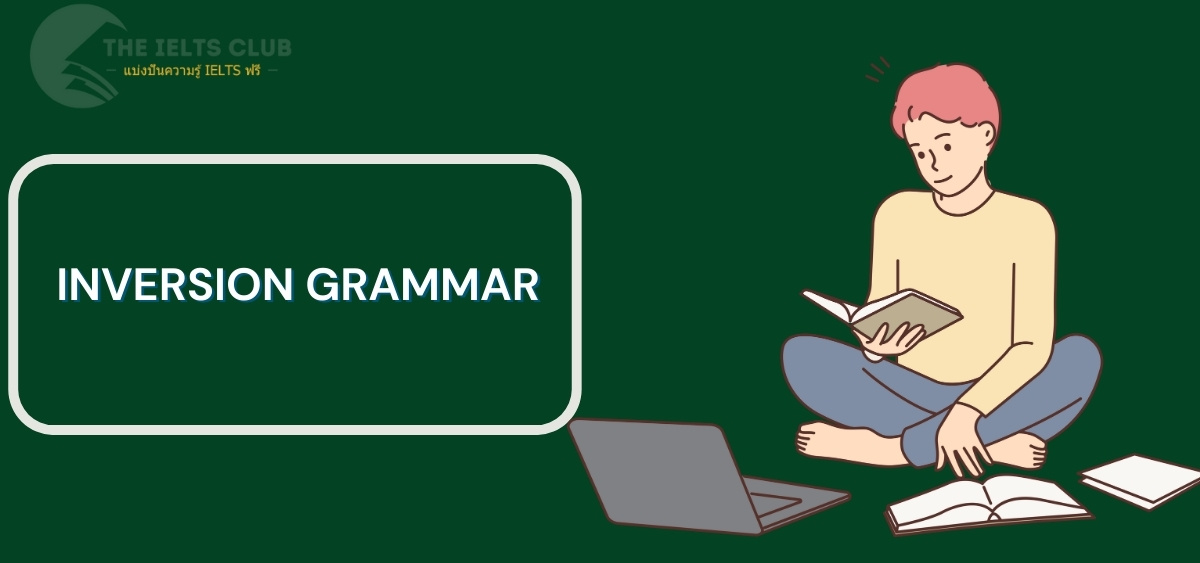หากคุณกำลังเรียนภาษาอังกฤษและต้องการรู้ว่า “infinitive คือ” หรือ “verb infinitive คือ” บทความนี้จะอธิบายวิธีใช้ Infinitive ในภาษาอังกฤษ ทั้งการใช้ “to” และไม่ใช้ “to” พร้อมตัวอย่างและแบบฝึกหัดที่เข้าใจง่าย
I. Infinitive คืออะไร?
Infinitive คือ รูปของคำกริยาในภาษาอังกฤษที่ไม่ได้ผันตามประธานและเวลาของประโยค แต่จะแสดงถึงความหมายพื้นฐานของคำกริยา เช่น “to eat”, “to go” ซึ่งเราจะพบการใช้ infinitive ในหลาย ๆ บริบทในภาษาอังกฤษ ไม่ว่าจะเป็นการแสดงความตั้งใจ เป้าหมาย หรือเพื่อแสดงการกระทำต่าง ๆ
ในบทความนี้ เราจะมาเรียนรู้วิธีการใช้ infinitive ทั้งที่มี “to” และไม่ใช้ “to” เพื่อให้คุณสามารถเข้าใจและนำไปใช้ได้อย่างถูกต้องในทุกสถานการณ์
II. โครงสร้างและการใช้ infinitive ที่มี “to”
การใช้ infinitive กับ “to” เป็นหนึ่งในวิธีการใช้ infinitive ที่พบได้บ่อยที่สุดในภาษาอังกฤษ โดยมีการใช้ในหลาย ๆ สถานการณ์ดังนี้:
- การใช้ infinitive กับ “to” เพื่อแสดงเป้าหมายหรือความตั้งใจในการกระทำ
เมื่อเราใช้ infinitive กับ “to” เพื่อแสดงถึงเป้าหมายหรือความตั้งใจในการกระทำ เราจะเห็นคำว่า “to” ตามด้วยคำกริยาหลัก เช่น
- They hope to improve their skills by practicing every day. (พวกเขาหวังที่จะพัฒนาทักษะของตนเองโดยการฝึกฝนทุกวัน)
- We plan to visit our grandparents this weekend. (เราวางแผนที่จะเยี่ยมคุณปู่คุณย่าของเราในสุดสัปดาห์นี้)
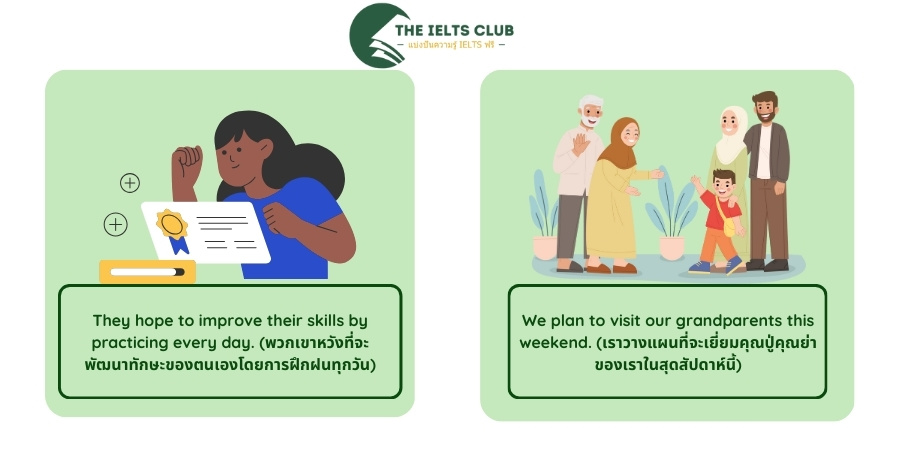
- การใช้ infinitive กับ “to” เพื่อทำหน้าที่เป็นประธานในประโยค
ในบางครั้ง infinitive จะถูกใช้เป็นประธานในประโยค โดยใช้ “to” ก่อนคำกริยา เช่น
- To achieve success requires hard work and determination. (การบรรลุความสำเร็จต้องการการทำงานหนักและความมุ่งมั่น)
- To travel around the world is her biggest dream. (การเดินทางรอบโลกคือลูกใหญ่ของเธอ)
- การใช้ infinitive กับ “to” เพื่ออธิบายสิ่งที่สามารถใช้ได้หรือมีการใช้งาน
บางครั้ง infinitive กับ “to” จะถูกใช้เพื่ออธิบายสิ่งที่สามารถใช้ได้หรือมีการใช้งาน เช่น
- This button is used to start the machine. (ปุ่มนี้ใช้สำหรับเริ่มเครื่องจักร)
- The website is designed to offer various online courses. (เว็บไซต์นี้ถูกออกแบบมาเพื่อให้บริการคอร์สออนไลน์หลากหลาย)
- การใช้ infinitive กับ “to” หลังคำคุณศัพท์
ในกรณีที่มีคำคุณศัพท์ก่อนคำกริยา infinitive จะถูกตามหลังคำคุณศัพท์ เช่น
- I’m afraid to speak in front of a large audience. (ฉันกลัวที่จะพูดต่อหน้าผู้ฟังจำนวนมาก)
- He was shocked to hear the news about his promotion. (เขาตกใจที่จะได้ยินข่าวเกี่ยวกับการเลื่อนตำแหน่งของเขา)
- การใช้ infinitive กับ “to” เพื่อแสดงความคิดเห็นหรือการตัดสินบางสิ่ง
การใช้ infinitive กับ “to” ยังสามารถแสดงความคิดเห็นหรือการตัดสินบางสิ่งได้ เช่น
- It is interesting to watch movies in different languages. (มันน่าสนใจที่จะดูภาพยนตร์ในหลายภาษา)
- It’s surprising to see her so happy after all the struggles. (มันน่าประหลาดใจที่จะเห็นเธอมีความสุขหลังจากการต่อสู้ทั้งหมด)
- การใช้ infinitive กับ “to” กับคำกริยาวิเศษณ์
บางคำกริยาวิเศษณ์ก็ต้องตามด้วย infinitive กับ “to” เช่น
- He spoke softly to avoid waking up the baby. (เขาพูดเบาๆ เพื่อหลีกเลี่ยงการปลุกทารก)
- She worked quickly to finish the project before the deadline. (เธอทำงานอย่างรวดเร็วเพื่อที่จะเสร็จโปรเจ็กต์ก่อนกำหนด)
- การใช้ infinitive กับ “to” ในคำถาม
บางครั้ง infinitive กับ “to” สามารถใช้ในคำถามได้ เช่น
- Would you like to join us for dinner tonight? (คุณอยากเข้าร่วมทานอาหารเย็นกับเราวันนี้มั้ย)
- Do you want to come with me to the concert? (คุณต้องการมาด้วยกันกับฉันไปคอนเสิร์ตไหม)
อ้างอิง:
- คำกริยา อังกฤษ | คู่มือเรียนรู้คำกริยาแบบละเอียด
- Modal verbs คืออะไร? วิธีการใช้กริยาช่วยและแบบฝึกหัดพร้อมคำตอบ
III. โครงสร้างและการใช้ infinitive ที่ไม่มี “to”
นอกจาก infinitive กับ “to” แล้ว ยังมีการใช้ infinitive แบบไม่ใช้ “to” โดยมีการใช้ในหลาย ๆ กรณีดังนี้:
- การใช้ infinitive แบบไม่ใช้ to หลังจากกริยาช่วย
หลังจาก กริยาช่วย (modal verbs) เช่น can, could, should, will, would, may, might, must, etc. จะใช้ infinitive แบบไม่ใช้ “to” เช่น
- She can play the piano very well. (เธอสามารถเล่นเปียโนได้ดีมาก)
- We must leave immediately. (เราต้องออกไปทันที)
- การใช้ infinitive แบบไม่ใช้ to หลังคำกริยาที่แสดงการรับรู้
คำกริยาบางคำที่แสดงการรับรู้เช่น see, hear, feel จะตามด้วย infinitive แบบไม่ใช้ “to” เช่น
- I felt her touch my hand. (ฉันรู้สึกว่าเธอแตะมือฉัน)
- He saw them enter the building. (เขาเห็นพวกเขาเข้าไปในอาคาร)
- การใช้ infinitive แบบไม่ใช้ to หลังคำกริยา “make” และ “let”
คำกริยา “make” และ “let” จะใช้ infinitive แบบไม่ใช้ “to” เช่น
- His actions made me question my own beliefs. (การกระทำของเขาทำให้ฉันตั้งคำถามกับความเชื่อของตัวเอง)
- The teacher let the students leave early. (ครูให้อนุญาตให้นักเรียนออกไปก่อนเวลา)
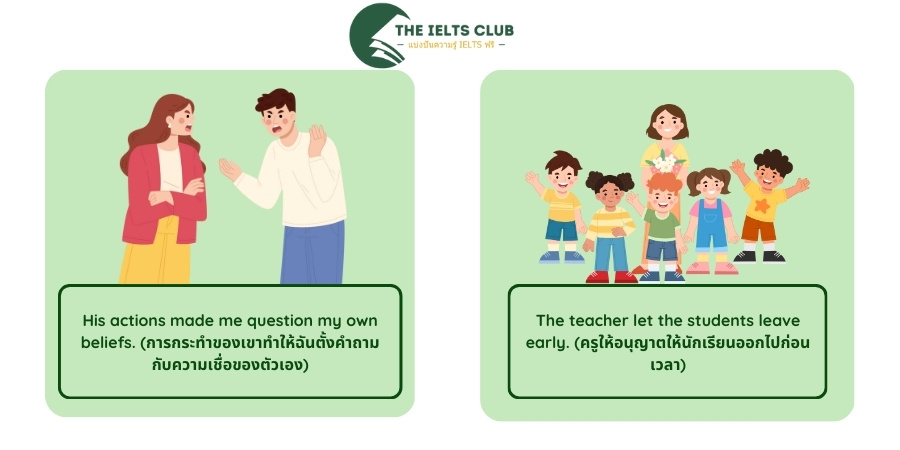
- การใช้ infinitive แบบไม่ใช้ to หลังสำนวน “had better”
สำนวน “had better” ใช้ infinitive แบบไม่ใช้ “to” เช่น
- You had better start saving money for your future. (คุณควรเริ่มเก็บเงินสำหรับอนาคตของคุณ)
- She had better hurry up or she will be late. (เธอควรรีบหน่อย มิฉะนั้นเธอจะมาสาย)
- การใช้ infinitive แบบไม่ใช้ to ในการถามคำถาม “why”
ในคำถามที่มี “why” การใช้ infinitive แบบไม่ใช้ “to” เช่น
- Why call him now? (ทำไมต้องโทรหาคุณตอนนี้)
Why go out when it’s raining? (ทำไมต้องออกไปเมื่อฝนตก)
IV. แบบฝึกหัดเกี่ยวกับ Infinitive ในไวยากรณ์ภาษาอังกฤษ
แบบฝึกหัดที่ 1: เติมคำในช่องว่างด้วย Infinitive ให้ถูกต้อง
คำชี้แจง: เติมคำในวงเล็บด้วยรูป Infinitive (ใช้ “to” หรือไม่ใช้ “to” ตามที่เหมาะสม) ให้ครบถ้วนตามบริบทของประโยค
- I want _______ (go) to the park.
- She helped me _______ (clean) the room.
- We need _______ (finish) the project by tomorrow.
- The teacher made us _______ (read) the chapter.
- I heard him _______ (sing) a beautiful song.
- It is important _______ (exercise) regularly.
- They decided _______ (cancel) the meeting.
- He let me _______ (borrow) his car.
- I can’t wait _______ (see) the new movie.
- You had better _______ (study) for the exam.
ตัวอย่างคำตอบสำหรับแบบฝึกหัดที่ 1
- I want to go to the park.
(ใช้ “to go” เพราะ “want” ตามด้วย Infinitive ที่มี “to”) - She helped me clean the room.
(หลังจาก “help” สามารถใช้ Infinitive โดยไม่ต้องมี “to” ได้) - We need to finish the project by tomorrow.
(ใช้ “to finish” หลัง “need” เพื่อแสดงความจำเป็น) - The teacher made us read the chapter.
(หลัง “made” ต้องใช้ Infinitive แบบไม่มี “to”) - I heard him sing a beautiful song.
(หลัง “heard” ใช้ Infinitive โดยไม่มี “to” เนื่องจากเป็นการรับรู้) - It is important to exercise regularly.
(ใช้ “to exercise” หลัง “important” เพื่อแสดงความสำคัญ) - They decided to cancel the meeting.
(หลัง “decided” ใช้ Infinitive ที่มี “to”) - He let me borrow his car.
(หลัง “let” ใช้ Infinitive แบบไม่มี “to”) - I can’t wait to see the new movie.
(ใช้ “to see” หลัง “can’t wait” เพื่อแสดงความตื่นเต้น) - You had better study for the exam.
(หลัง “had better” ต้องใช้ Infinitive แบบไม่มี “to”)
แบบฝึกหัดที่ 2: เลือกคำตอบที่ถูกต้อง
คำชี้แจง: เลือกคำตอบ Infinitive ที่ถูกต้องสำหรับแต่ละประโยคด้านล่าง
- They promised _______ (help) us with the project.
- A. help
- B. to help
- C. helping
- I saw her _______ (dance) gracefully at the party.
- A. to dance
- B. dance
- C. dancing
- It’s essential _______ (be) kind to others.
- A. be
- B. to be
- C. being
- He made me _______ (apologize) for my mistake.
- A. to apologize
- B. apologize
- C. apologizing
- We can’t afford _______ (miss) this opportunity.
- A. missing
- B. to miss
- C. miss
ตัวอย่างคำตอบ:
- B. to help
- B. dance
- B. to be
- B. apologize
- B. to miss
แบบฝึกหัดที่ 3: แปลงประโยคโดยใช้ Infinitive
คำชี้แจง: แปลงประโยคด้านล่างให้ใช้ Infinitive (ให้เลือกใช้รูปที่มี “to” หรือไม่ใช้ “to” ตามความเหมาะสม)
- (I decided to / I decided that I should) study harder.
- (He made me / He made me to) wait for an hour.
- (She wants / She wants to) visit Japan next year.
- (We heard / We heard them) sing at the concert.
- (They let / They let us to) use their computer.
ตัวอย่างคำตอบ:
- I decided to study harder.
- He made me wait for an hour.
- She wants to visit Japan next year.
- We heard them sing at the concert.
- They let us use their computer.
Infinitive เป็นองค์ประกอบที่สำคัญในภาษาอังกฤษที่คุณควรรู้จัก ทั้งในกรณีที่ใช้ “to-infinitive” และ bare infinitive การเข้าใจและใช้ infinitive อย่างถูกต้องจะช่วยเพิ่มความมั่นใจในการพูดและเขียนภาษาอังกฤษของคุณ อย่าลืมฝึกฝนด้วยตัวอย่างและแบบฝึกหัดที่เรานำเสนอในบทความนี้เพื่อเพิ่มทักษะของคุณในการใช้ infinitive ในสถานการณ์ต่าง ๆ.
